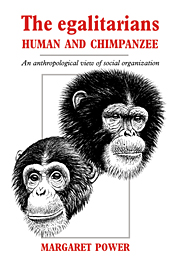Book contents
- Frontmatter
- Contents
- Foreword by A. Montagu
- Acknowledgments
- Part 1 Methods and prefatory explanations
- Part 2 The human foragers
- Part 3 The changing social order
- Part 4 The behavior of wild and provisioned groups: a theoretical analysis
- Part 5 The mutual dependence system
- Part 6 The egalitarian chimpanzees
- Part 7 Probabilities, possibilities and half-heard whispers
- Notes
- References
- Index
Part 4 - The behavior of wild and provisioned groups: a theoretical analysis
Published online by Cambridge University Press: 18 December 2009
- Frontmatter
- Contents
- Foreword by A. Montagu
- Acknowledgments
- Part 1 Methods and prefatory explanations
- Part 2 The human foragers
- Part 3 The changing social order
- Part 4 The behavior of wild and provisioned groups: a theoretical analysis
- Part 5 The mutual dependence system
- Part 6 The egalitarian chimpanzees
- Part 7 Probabilities, possibilities and half-heard whispers
- Notes
- References
- Index
Summary
Foraging theory: when, and when not, to defend territory
The degree of exclusive use of a territory varies widely among animal species, from almost total control to sharing significant portions of the area and its resources with outsiders (Myers, Connors and Pitelka 1981). Animals do not usually defend a territory, excluding others, unless the benefits of so doing exceed the costs. In this section, the behavior of the wild chimpanzees, and the provisioned Gombe and Mahale groups, will be considered in terms of foraging theory (costs and net benefits), frustration, and competition theories.
Customarily, the term foraging is used to refer to behavior associated with searching for, obtaining and consuming wild foods. Foraging strategy refers to the way in which foraging animals achieve a particular goal. Animals that adopt the most successful strategy forage ‘optimally’ and are favored by natural selection (Krebs 1981). The goal and criterion of success might be to obtain as much food as possible or to minimize the time spent foraging each day in order to ‘bank’ time and energy for other activities, such as seeking mates, reproduction, resting, grooming, antipredator behavior and so on. Foraging strategy is often viewed in terms of the tactical ‘decisions’ that animals make, as to which food items to seek and when, where and how to do so. As Krebs (1981) puts it, in terms of fitness the foremost question is: what tactics should an animal adopt that will be most effective toward reaching its goal?
- Type
- Chapter
- Information
- The Egalitarians - Human and ChimpanzeeAn Anthropological View of Social Organization, pp. 125 - 150Publisher: Cambridge University PressPrint publication year: 1991

